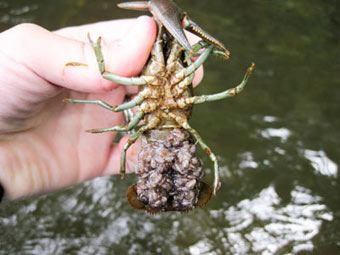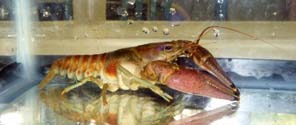Long-term lake study suggests ecological mechanism may control destructive crayfish
Just a few years ago, scientists at the University of Wisconsin–Madison’s research station in Boulder Junction, Wis., were growing sick of a crustacean delicacy — the rusty crayfish. Roughly 90,000 of the animals had been caught during an intensive trapping program at the nearby Sparkling Lake.

A female rusty crayfish with partially developed eggs attached to her abdomen. Gretchen Hansen, a zoology graduate student at UW–Madison, is monitoring the invasive rusty crayfish in Sparkling Lake, Wis., where trapping and native, carnivorous fish have caused a dramatic population decline, helping to restore natural conditions to the lake.
Photo: Gretchen Hansen
Many of them wound up in tasty Cajun food served at the Trout Lake Research Station.
But after years of work, these scientists may be closing in on a method to restore the native plants and animals to northern lakes after invasion of the rusty crayfish.
The 110-acre Sparkling Lake was colonized by the crayfish roughly 30 years ago, a fate it shares with thousands of other Wisconsin water bodies.
Once established in a lake or stream, rusty crayfish lawn-mows plants living on the bottom, eliminating habitat for native crayfish and sport fish, and eating large numbers of fish eggs, causing an ecosystem-wide and often irreversible change in habitat.
Scientists consider invasive species one of the most significant causes of disturbance in native ecosystems, since established invaders can be difficult or impossible to control. Rusty crayfish are one of the most problematic invasive species in Wisconsin waters.
Trapping was the first stage in a long-term control effort. In 2001, the average trap caught 25 rusty crayfish each day. Now, it takes 10 traps, on average, to catch a single invader in a day.
Populations of two native fishes, the pumpkinseed and the bluegill, are both expanding, as is the number of native crayfish, which was close to extinction. “The lake is recovering, and the rusty crayfish don’t appear to be coming back,” says graduate student Gretchen Hansen.

A male rusty crayfish, or Orconectes rusticus, found in Sparking Lake in northern Wisconsin.
Photo: Brian Roth
Although traps are still used to count crayfish, trapping for removal ceased in 2009, and the project is now relying on native predatory fishes such as bluegill and bass to control the rusty crayfish, says Timothy Kratz, manager of the UW–Madison’s Trout Lake Research Station.
“We’ve had cooperation from the Department of Natural Resources, which has protected the largest, most fecund predators, and stocked walleye and other predators,” says Stephen Carpenter, a professor of zoology at UW–Madison. “In addition, the Lac du Flambeau fishers have agreed not to harvest walleye from Sparkling Lake during the experiment.”
All these changes have helped increase predation and pressured the rusty crayfish, but a severe drought has also helped, adds Carpenter. “The low water level has put most of the good crayfish habitat high and dry.”
Because Sparkling Lake is part of the National Science Foundation-supported Long-Term Ecological Research network, scientists know that the rusty crayfish also declined during a previous drought, Carpenter says. “We’ve seen the same response, so it’s really powerful evidence that low water levels do affect it. By harvesting these crayfish ourselves, and then changing the predation, we may be able to keep the numbers at an acceptable level.”
Staff from the Trout Lake research station will continue to monitor Sparkling Lake, seeking to determine whether the native fish are indeed doing their job.
Ecological restoration is always in need of new techniques, Carpenter says. “Sometimes you feel like the Dutch boy with your finger in the dike. I hope we’ve found a way to deal with the rusty crayfish, so we can move on to other problems, but we won’t know the answer for several years.”
Tags: biosciences, research, water



